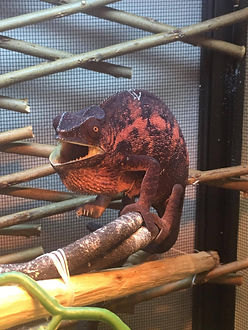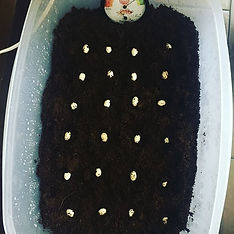The Panther Chameleon in general is a fascinating creature to own. Whether you are interested in a female Panther Chameleon as a pet, breeding project, or both the males and females need slightly different set-ups and care. If you are interested in owning a female, I will tell you what has worked for me. What has worked for me may result in a different outcome for you, trust your judgement. As I always say, suit them to their needs because each Chameleon can be different.
A lot of people say, female chameleons are not as bright and colorful as the males. I don’t believe that statement to be true 100%. Females can be just as bright but more shades of pinks, and purples. They have a soft touch to them which to me makes them pretty and dainty. Don’t let those shades fool you. Chameleon’s colors change as they grow and shed. At about 24 months, their colors should have fully come in.
Panther Chameleons are tamer than many chameleon species. It is noted that chameleons should be handled as little as possible although it really depends on the needs of your chameleon.
I have a female Panther Chameleon that HATES me looking at

her, unless I have food in my hands. Occasionally, she will decide to be adventurous and come out of her cage to go on her free-roam area but even at those times it doesn’t last long. She’s shy and likes to keep to herself. Then, I have a male Panther who can’t wait till he gets to free-roam and sometimes doesn’t want to go back into his cage! It really depends on each chameleon.
It has come to a surprise to many new reptile keepers that females will lay eggs regardless if they’re mated or not.
Well, TOTAL SHOCKER! Like chickens, female chameleons will start producing clutches of infertile eggs regularly throughout their lives. Many people are discouraged

to own a female chameleon by the fear of them running into a medical issue such as egg-binding or becoming egg-bound. The good news is that most of your fear is created by the online hype. Yes, it’s unfortunate that things happen beyond our control and like with any female birth, it’s not always a smooth thing. Female chameleons know what they’re doing better than we do, as long as they have a proper place to lay and are healthy there should be nothing to stress about regarding egg-laying.
An unhealthy female chameleon can result in problems while laying eggs. Make sure your chameleon has access to high quality UVB bulbs and nutritional feeders. The proper supplementation with calcium and other vitamins will aid to a strong and healthy female that is able to produce and lay eggs safely. Because females are generally smaller than males the required cage size can be smaller. (3"x 2”x 2”) Females are just as, if not more active than my males so larger cages are acceptable. It is really up to your preference and chameleons needs. Providing a larger cage will make it easier to provide more room for a laying bin.
A GOOD HUSBANDRY LEADS TO HEALTHY FEMALES WHICH LAY EGGS WITH LITTLE ISSUES.
So like I’ve said, females will lay clutches all throughout their lives, and dealing with eggs will be a part of your female’s husbandry even if she is a single pet. That being said, you will need a proper laying bin for your female to feel comfortable. A laying bin can be any container that can be filled at least 10-12 inches deep and 8-9 inches wide with a mix of moisten fine sand and organic soil where the female can dig and lay her eggs. The female will often dig a tunnel all the way to the bottom of the container, most of the time they will use all 12 inches of the sand mixture.
Some females are sassy and stubborn. If you notice that their not comfortable with the laying bin you’ve provided, try planting a small plant in the soil or place a branch going down into the container. I’ve noticed that my females like to lay their eggs around the under roots of the plant. For reasons that are not obvious, females have been known to be hesitant to use the provided laying bin. If she doesn’t begin to dig a tunnel she may not be ready yet. I keep my laying bins in the cage the whole time until she lays a clutch, then I will retrieve the eggs, put in a new mixture and the laying bin will go back in the cage.
One time-
I noticed one of my females having issues with her laying bin. I tried everything. New soil, new sand, new mixture, new moist level. NOTHING WORKED.
A day later, I came to find out that one of my other live plants got for her had an ant farm inside causing her stress!!!
(I wash all live plants before entering cages so I wasn't expecting that to happen)
None-the-less, I went ahead and cleaned the whole cage, got rid of the live plant containing the ant farm, re-put in the laying bin and taped off the sides of her cage with double-sided tape to prevent ants from getting inside. A few hours later, my female had laid her clutch in the provided laying bin peacefully.
Please note: what has worked for me may be different for someone else.
Following these steps should help make owning a female pretty much stress-free. Female Chameleons can make the best pets, but the egg-laying usually scares the new keepers away from owning a female. Follow good husbandry practices and providing a private place to lay, keeping a female should be no more difficult than owning a male.
www.prettypantherchams.com
A lot of people say, female chameleons are not as bright and colorful as the males. I don’t believe that statement to be true 100%. Females can be just as bright but more shades of pinks, and purples. They have a soft touch to them which to me makes them pretty and dainty. Don’t let those shades fool you. Chameleon’s colors change as they grow and shed. At about 24 months, their colors should have fully come in.
Panther Chameleons are tamer than many chameleon species. It is noted that chameleons should be handled as little as possible although it really depends on the needs of your chameleon.
I have a female Panther Chameleon that HATES me looking at

her, unless I have food in my hands. Occasionally, she will decide to be adventurous and come out of her cage to go on her free-roam area but even at those times it doesn’t last long. She’s shy and likes to keep to herself. Then, I have a male Panther who can’t wait till he gets to free-roam and sometimes doesn’t want to go back into his cage! It really depends on each chameleon.
It has come to a surprise to many new reptile keepers that females will lay eggs regardless if they’re mated or not.
Well, TOTAL SHOCKER! Like chickens, female chameleons will start producing clutches of infertile eggs regularly throughout their lives. Many people are discouraged

to own a female chameleon by the fear of them running into a medical issue such as egg-binding or becoming egg-bound. The good news is that most of your fear is created by the online hype. Yes, it’s unfortunate that things happen beyond our control and like with any female birth, it’s not always a smooth thing. Female chameleons know what they’re doing better than we do, as long as they have a proper place to lay and are healthy there should be nothing to stress about regarding egg-laying.
An unhealthy female chameleon can result in problems while laying eggs. Make sure your chameleon has access to high quality UVB bulbs and nutritional feeders. The proper supplementation with calcium and other vitamins will aid to a strong and healthy female that is able to produce and lay eggs safely. Because females are generally smaller than males the required cage size can be smaller. (3"x 2”x 2”) Females are just as, if not more active than my males so larger cages are acceptable. It is really up to your preference and chameleons needs. Providing a larger cage will make it easier to provide more room for a laying bin.
A GOOD HUSBANDRY LEADS TO HEALTHY FEMALES WHICH LAY EGGS WITH LITTLE ISSUES.
So like I’ve said, females will lay clutches all throughout their lives, and dealing with eggs will be a part of your female’s husbandry even if she is a single pet. That being said, you will need a proper laying bin for your female to feel comfortable. A laying bin can be any container that can be filled at least 10-12 inches deep and 8-9 inches wide with a mix of moisten fine sand and organic soil where the female can dig and lay her eggs. The female will often dig a tunnel all the way to the bottom of the container, most of the time they will use all 12 inches of the sand mixture.
Some females are sassy and stubborn. If you notice that their not comfortable with the laying bin you’ve provided, try planting a small plant in the soil or place a branch going down into the container. I’ve noticed that my females like to lay their eggs around the under roots of the plant. For reasons that are not obvious, females have been known to be hesitant to use the provided laying bin. If she doesn’t begin to dig a tunnel she may not be ready yet. I keep my laying bins in the cage the whole time until she lays a clutch, then I will retrieve the eggs, put in a new mixture and the laying bin will go back in the cage.
One time-
I noticed one of my females having issues with her laying bin. I tried everything. New soil, new sand, new mixture, new moist level. NOTHING WORKED.
A day later, I came to find out that one of my other live plants got for her had an ant farm inside causing her stress!!!
(I wash all live plants before entering cages so I wasn't expecting that to happen)
None-the-less, I went ahead and cleaned the whole cage, got rid of the live plant containing the ant farm, re-put in the laying bin and taped off the sides of her cage with double-sided tape to prevent ants from getting inside. A few hours later, my female had laid her clutch in the provided laying bin peacefully.
Please note: what has worked for me may be different for someone else.
Following these steps should help make owning a female pretty much stress-free. Female Chameleons can make the best pets, but the egg-laying usually scares the new keepers away from owning a female. Follow good husbandry practices and providing a private place to lay, keeping a female should be no more difficult than owning a male.
www.prettypantherchams.com
